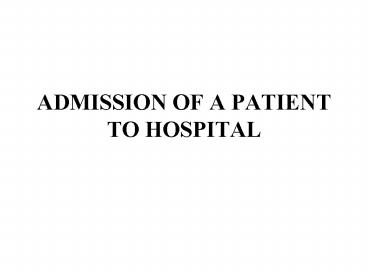ADMISSION OF A PATIENT TO HOSPITAL - PowerPoint PPT Presentation
1 / 23
Title:
ADMISSION OF A PATIENT TO HOSPITAL
Description:
Past illnesses that have any residual effects of bearing. ... Chews and swallows easily. PATIENT ASSESSMENT 3. Eats balanced diet. Use of dentures ... – PowerPoint PPT presentation
Number of Views:4423
Avg rating:3.0/5.0
Title: ADMISSION OF A PATIENT TO HOSPITAL
1
ADMISSION OF A PATIENT TO HOSPITAL
2
DOCUMENTS FOR ADMISSION ASSESSMENT
3
ADMISSION INTERVIEW
- Note-
- The reason for admission - as the patient
understands it. - The symptoms the patient has.
- Past illnesses that have any residual effects of
bearing. - Any problems the patient had with previous
admissions.
4
- Any allergies the patient has.
- Any medications taken - what for? AS the patient
understands it. Any non-compliance and why. - Smoking and drinking habits.
- Last menstrual period (where relevant).
5
PATIENT ASSESSMENT 1
- OBSERVATIONS AND PHYSICAL ASSESSMENT
- To be carried out as quickly as possible on
admission to the ward.
6
PATIENT ASSESSMENT
- Vital signs within normal range
- Oriented to reality, time, place and person
- Pulse regular, full and equal
- Peripheral pulses present
- Normal chest movements
- No shortness of breath
7
PATIENT ASSESSMENT
- No signs of infection
- Pressure areas intact
- Skin warm
- Pink healthy colour of skin and mucous membranes
8
PATIENT ASSESSMENT 2
- SENSORY REGULATION
- Awake, alert, asleep
- At ease, comfortable
- Able to see, use of glasses
- Appropriate size, colour and shape of eyes
- Sclera white
9
PATIENT ASSESSMENT 2
- Pupils equal, react
- Hears voices within normal range
- Use of hearing aid
- Abe to sense by touch
10
PATIENT ASSESSMENT 3
- FOOD AND DRINK
- Weight in normal range for age, height
- Maintains usual body weight
- No restrictions of food
- Eats normally and retains food
- Chews and swallows easily
11
PATIENT ASSESSMENT 3
- Eats balanced diet
- Use of dentures
- Teeth and gums - strong and smooth
- Adequate fluid intake/output
- Urine has normal colour
- No abnormal fluid loss
- Pink moist mucous membranes
12
PATIENT ASSESSMENT 4
- ELIMINATION
- Has regular bowel movement every 1 to 3 days
- Formed brown stool, moderate amount
- Abdomen soft, active bowel sounds
- Able to void urine comfortably
- Urine has normal characteristics
13
PATIENT ASSESSMENT 5
- SLEEP AND REST
- Usual bedtime_______
- Usual rising time_____
- Naps_______________
- No interruptions of sleep
- Awakes well rested, feels refreshed
- Falls asleep easily
14
PATIENT ASSESSMENT 6
- Activity
- Limbs present, in good proportion
- Good muscle size
- Smooth, co-ordinated movement
- Unrestricted movement of joints
- Good strength, moves independently
15
PATIENT ASSESSMENT 6
- Good balance able to weight bear
- Able to change position freely
- Walks without assistance, normal gait
- Performs daily living activities
16
PATIENT ASSESSMENT 7
- SELF EXPRESSION
- Able to express thoughts and feelings
- Body language congruent with speech
- Has realistic expectations about illness
17
PATIENT ASSESSMENT 7
- Able to accept and cope with changes in body/loss
- Able to make decisions about care
- Feels able to cope
18
PATIENT ASSESSMENT 8
- SOCIAL
- Able to interact socially
- Has support of family/loved ones
- Social support is continued throughout admission
- Unworried about family/loved ones
- Ability to cope at home
19
RISK ASSESSMENT
- Falls
- Pressure sores
- Lifting and handling
20
CARE PLANNING
21
DISCHARGE PLANNING
- Planning of assessment for discharge should
begin from the point of admission.
22
DISCHARGE 2
- Most patients discharged from hospital are able
to return home with little or no support, while
others will require a package of care to
support them back to optimum health.
23
DISCHARGE 3
- An accurate assessment of the patients care
needs should be communicated to relevant service
providers. - A realistic discharge date should be set.

